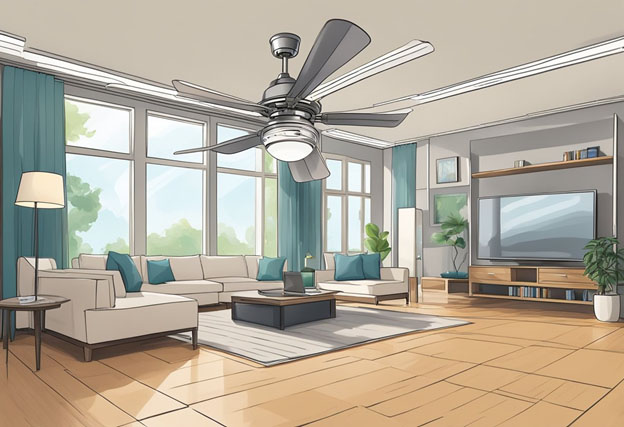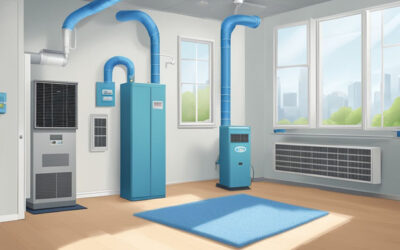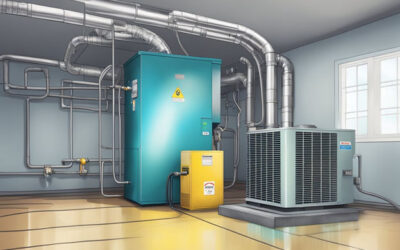Ceiling fans are a common fixture in many households and are often used to provide relief from the heat. However, there is a common misconception that ceiling fans cool the air in a room. In reality, ceiling fans do not actually lower the temperature of a room, but they can make it feel cooler by creating a wind chill effect.
The wind chill effect is the sensation of feeling cooler due to the movement of air across the skin. When a ceiling fan is turned on, it creates a gentle breeze that can make a room feel more comfortable, even if the temperature remains the same. This is because the movement of air helps to evaporate moisture from the skin, which cools the body. However, it is important to note that ceiling fans do not actually lower the temperature of a room and should not be relied upon as the sole source of cooling in very hot weather.
Understanding Ceiling Fans
Ceiling fans are a common feature in many homes and are often used to provide a cooling effect during hot weather. However, there are several misconceptions about how ceiling fans work and their effectiveness in cooling the air. This section aims to provide a clear understanding of the mechanics of air movement and the perception vs. reality of using ceiling fans.
Mechanics of Air Movement
Ceiling fans work by creating a wind-chill effect that cools the skin through the evaporation of sweat. The blades of the fan rotate in a circular motion, creating a downward flow of air. This downward flow of air creates a breeze that can make the skin feel cooler.
It is important to note that ceiling fans do not actually lower the temperature of the air in the room. Instead, they create a cooling effect by moving the air around and providing a breeze that can make the skin feel cooler. This means that ceiling fans are most effective when used in conjunction with an air conditioning system, as they can help to circulate the cool air around the room.
Perception vs. Reality
One common misconception about ceiling fans is that they can cool the air in the room without the need for an air conditioning system. While ceiling fans can create a cooling effect, they do not actually lower the temperature of the air in the room. This means that if the temperature outside is very hot, a ceiling fan alone may not be sufficient to keep the room cool.
Another common misconception is that ceiling fans are only useful during the summer months. In reality, ceiling fans can be used year-round to help circulate air and improve ventilation in the room. During the winter months, ceiling fans can be set to rotate in the opposite direction, creating an upward flow of air that can help to distribute warm air throughout the room.
In conclusion, understanding the mechanics of air movement and the perception vs. reality of using ceiling fans is important for making informed decisions about how to best use this common household appliance. When used in conjunction with an air conditioning system, ceiling fans can be an effective way to improve air circulation and create a more comfortable living environment.
The Role of Ceiling Fans in Comfort
Ceiling fans are often misunderstood as devices that reduce the temperature of a room. However, their primary function is to provide a cooling effect through air circulation. This section will explore the various ways in which ceiling fans contribute to the comfort of a room.
Psychological Cooling Effects
Ceiling fans create a psychological cooling effect that makes a room feel more comfortable, even if the temperature remains the same. The gentle breeze created by the fan can make a person feel up to 8 degrees cooler, which can be a significant difference in comfort. This effect is due to the evaporative cooling effect of sweat on the skin, which is enhanced by the air movement.
Air Circulation and Ventilation
Ceiling fans improve air circulation and ventilation in a room. They help to distribute cool air from air conditioning systems and can also be used to circulate warm air during the winter months. This circulation helps to maintain a consistent temperature throughout the room and reduce hot spots. Additionally, ceiling fans can improve indoor air quality by reducing the concentration of pollutants and allergens in the air.
In conclusion, ceiling fans play an important role in creating a comfortable environment in a room. They provide a psychological cooling effect and improve air circulation and ventilation. While they do not actually lower the temperature of a room, they can make it feel more comfortable and reduce the need for air conditioning, which can result in energy savings.
Energy Efficiency and Ceiling Fans
Ceiling fans are known for their energy efficiency and cost-effectiveness. In this section, we will explore how ceiling fans compare to air conditioners in terms of energy consumption and how to optimize the energy use of ceiling fans.
Comparison with Air Conditioners
Air conditioners consume a significant amount of energy, which results in high electricity bills. On the other hand, ceiling fans consume much less energy and can be used in conjunction with air conditioners to help reduce energy costs.
A ceiling fan can make a room feel cooler by creating a wind chill effect, which makes people feel cooler without actually lowering the temperature of the room. In contrast, air conditioners lower the temperature of the room, which requires more energy and results in higher electricity bills.
To put it into perspective, a typical ceiling fan uses around 60 watts of energy, while a window air conditioner uses around 500 watts. This means that running a ceiling fan for 12 hours a day costs around $1.50 per month, while running an air conditioner for the same amount of time costs around $40 per month.
Optimizing Energy Use
To optimize the energy use of ceiling fans, it’s important to use them correctly. Here are a few tips to help you use your ceiling fan more efficiently:
- Turn off the fan when you leave the room. Ceiling fans cool people, not rooms, so there’s no point in running the fan when no one is in the room.
- Adjust the fan speed based on the temperature and humidity. In the summer, a higher fan speed will create a stronger wind chill effect, while in the winter, a lower fan speed will help circulate warm air.
- Use a ceiling fan with an Energy Star rating. Energy Star ceiling fans are 60% more efficient than conventional fans and can save you up to $15 per year on your electricity bill.
By following these tips, you can maximize the energy efficiency of your ceiling fan and reduce your energy costs.
Choosing the Right Ceiling Fan
Ceiling fans can be a great addition to any room, not only for their aesthetic appeal but also for their functionality. However, choosing the right ceiling fan can be a daunting task, especially if you are not familiar with the different types available in the market. In this section, we will discuss some important factors that you should consider when choosing a ceiling fan.
Size and Blade Design
The size of the ceiling fan is an important consideration when choosing a fan. A fan that is too small for the room will not circulate the air properly, while a fan that is too large can be overpowering and noisy. To determine the right size for your room, measure the length and width of the room and use a ceiling fan size chart to find the appropriate fan size.
Blade design is another important factor to consider when choosing a ceiling fan. The number of blades and their shape can affect the fan’s performance. Fans with fewer blades tend to be more efficient and quieter, while fans with more blades provide more air movement. Additionally, the angle of the blades can affect the fan’s ability to circulate air.
Installation Considerations
Before purchasing a ceiling fan, it is important to consider the installation process. Some ceiling fans require professional installation, while others can be easily installed by homeowners. It is important to ensure that the fan you choose is compatible with your ceiling height and electrical wiring.
Another important consideration is the fan’s control options. Some fans come with remote controls, while others require wall switches. It is important to choose a fan with a control option that is convenient for you.
In conclusion, choosing the right ceiling fan requires careful consideration of factors such as size, blade design, installation, and control options. By taking these factors into account, you can ensure that you choose a fan that not only looks great but also functions efficiently and effectively.
Maintenance Tips for Ceiling Fans
Regular Cleaning
Regular cleaning is essential to keep the ceiling fan running smoothly and efficiently. Dust and dirt can accumulate on the blades and motor, causing the fan to wobble or make noise. To clean the fan, turn off the power and carefully wipe down the blades with a damp cloth. Do not use abrasive cleaners or water directly on the motor.
Periodic Inspections
Periodic inspections are necessary to ensure that the ceiling fan is safe to use. Check the mounting bracket and screws to make sure they are secure. Inspect the blades for cracks or warping, which can affect the balance of the fan. If the fan wobbles, it may be necessary to balance the blades using a balancing kit.
It is also important to check the wiring and electrical connections. Loose connections or frayed wires can be a fire hazard. If there are any signs of damage or wear, the fan should be repaired or replaced by a qualified electrician.
By following these maintenance tips, a ceiling fan can provide years of reliable service. Regular cleaning and inspections can help to keep the fan running smoothly and safely.
Environmental Impact of Ceiling Fans
Material and Manufacturing
Ceiling fans are made of various materials such as wood, metal, and plastic. The manufacturing process of these materials requires energy and resources, which can have a negative impact on the environment. For example, the production of metal requires mining, which can cause soil erosion and water pollution. Similarly, the production of plastic requires the use of fossil fuels, which contribute to greenhouse gas emissions.
However, some manufacturers have started using sustainable materials like bamboo and recycled plastic to reduce the environmental impact of ceiling fans. Additionally, some companies are implementing eco-friendly manufacturing practices such as using renewable energy sources and reducing waste.
End-of-Life Disposal
Ceiling fans have a long lifespan, but eventually, they will need to be disposed of. Improper disposal can have negative impacts on the environment. For example, if a ceiling fan is sent to a landfill, it can release harmful chemicals into the air and soil.
To reduce the environmental impact of ceiling fan disposal, it is important to recycle them properly. Many components of ceiling fans can be recycled, such as the metal parts and the motor. Some manufacturers even offer take-back programs where they will recycle the fan for you.
Overall, while ceiling fans do have an environmental impact, there are steps that can be taken to reduce it. By using sustainable materials and manufacturing practices and properly disposing of old fans, the impact can be minimized.





0 Comments